1
4
C Program Control
2007 Pearson Education, Inc. All rights reserved.
2
OBJECTIVES
In this chapter you will learn: The essentials of counter-controlled repetition. To use the for and do...while repetition statements to
execute statements in a program repeatedly.
To understand multiple selection using the switch
selection statement.
To use the break and continue program control
statements to alter the flow of control.
To use the logical operators to form complex conditional
expressions in control statements.
To avoid the consequences of confusing the equality and
assignment operators.
2007 Pearson Education, Inc. All rights reserved.
3
4.1 Introduction
This chapter introduces
– Additional repetition control structures
- for - do…while
– switch multiple selection statement
– break statement
- Used for exiting immediately and rapidly from certain
control structures – continue statement
- Used for skipping the remainder of the body of a repetition structure and proceeding with the next iteration of the loop
2007 Pearson Education, Inc. All rights reserved.
4
4.2 Repetition Essentials
Loop
– Group of instructions computer executes repeatedly while
some condition remains true Counter-controlled repetition
– Definite repetition: know how many times loop will execute – Control variable used to count repetitions
Sentinel-controlled repetition
– Indefinite repetition – Used when number of repetitions not known – Sentinel value indicates "end of data"
2007 Pearson Education, Inc. All rights reserved.
5
4.3 Counter-Controlled Repetition
Counter-controlled repetition requires
– The name of a control variable (or loop counter) – The initial value of the control variable – An increment (or decrement) by which the control variable
is modified each time through the loop
– A condition that tests for the final value of the control
variable (i.e., whether looping should continue)
2007 Pearson Education, Inc. All rights reserved.
6
4.3 Counter-Controlled Repetition
Example:
int counter = 1; // initialization while ( counter <= 10 ) { // repetition condition printf( "%d\n", counter ); ++counter; // increment }
– The statement
int counter = 1;
- Names counter - Defines it to be an integer - Reserves space for it in memory - Sets it to an initial value of 1
2007 Pearson Education, Inc. All rights reserved.
Outline
fig04_01.c
Definition and assignment are performed
simultaneously
7
2007 Pearson Education, Inc. All rights reserved.
8
4.3 Counter-Controlled Repetition
Condensed code
– C Programmers would make the program more concise – Initialize counter to 0
- while ( ++counter <= 10 )
printf( “%d\n, counter );
2007 Pearson Education, Inc. All rights reserved.
9
4.4 for Repetition Statement
Format when using for loops
for ( initialization; loopContinuationTest; increment )
statement
Example:
for( int counter = 1; counter <= 10; counter++ )
printf( "%d\n", counter );
– Prints the integers from one to ten
2007 Pearson Education, Inc. All rights reserved.
10
Fig. 4.3 | for statement header components.
2007 Pearson Education, Inc. All rights reserved.
Outline
fig04_02.c
11
for loop begins by setting counter to 1 and repeats while counter <= 10. Each time the end of the loop is reached, counter is incremented by 1.
2007 Pearson Education, Inc. All rights reserved.
12
4.4 for Repetition Statement
For loops can usually be rewritten as while loops:
initialization; while ( loopContinuationTest ) { statement; increment; }
Initialization and increment – Can be comma-separated lists – Example:
for (int i = 0, j = 0; j + i <= 10; j++,
i++)
printf( "%d\n", j + i );
2007 Pearson Education, Inc. All rights reserved.
13
Software Engineering Observation 4.1
Place only expressions involving the control variables in the initialization and increment sections of a for statement. Manipulations of other variables should appear either before the loop (if they execute only once, like initialization statements) or in the loop body (if they execute once per repetition, like incrementing or decrementing statements).
2007 Pearson Education, Inc. All rights reserved.
14
Common Programming Error 4.4
Placing a semicolon immediately to the right of a for header makes the body of that for statement an empty statement. This is normally a logic error.
2007 Pearson Education, Inc. All rights reserved.
15
4.5 for Statement : Notes and Observations
Arithmetic expressions
– Initialization, loop-continuation, and increment can contain
arithmetic expressions. If x equals 2 and y equals 10 for ( j = x; j <= 4 * x * y; j += y / x )
is equivalent to
for ( j = 2; j <= 80; j += 5 )
Notes about the for statement:
– "Increment" may be negative (decrement) – If the loop continuation condition is initially false - The body of the for statement is not performed - Control proceeds with the next statement after the for statement
– Control variable
- Often printed or used inside for body, but not necessary
2007 Pearson Education, Inc. All rights reserved.
16
Error-Prevention Tip 4.3
Although the value of the control variable can be changed in the body of a for loop, this can lead to subtle errors. It is best not to change it.
2007 Pearson Education, Inc. All rights reserved.
17
Fig. 4.4 | Flowcharting a typical for repetition statement.
2007 Pearson Education, Inc. All rights reserved.
• Sum all the even integers from 2 to 100
Outline
fig04_05.c
Note that number has a different value each time this statement is executed
19
2007 Pearson Education, Inc. All rights reserved.
20
Good Programming Practice 4.5
Although statements preceding a for and statements in the body of a for can often be merged into the for header, avoid doing so because it makes the program more difficult to read.
2007 Pearson Education, Inc. All rights reserved.
21
Good Programming Practice 4.6
Limit the size of control-statement headers to a single line if possible.
2007 Pearson Education, Inc. All rights reserved.
Outline
additional header
fig04_06.c
(1 of 2 )
23
pow function calculates the value of the first argument raised to the power of the second argument
2007 Pearson Education, Inc. All rights reserved.
Outline
fig04_06.c
(2 of 2 )
24
2007 Pearson Education, Inc. All rights reserved.
25
Error-Prevention Tip 4.4
Do not use variables of type float or double to perform monetary calculations. The impreciseness of floating-point numbers can cause errors that will result in incorrect monetary values.
2007 Pearson Education, Inc. All rights reserved.
Exercise
Exercise
28
4.7 switch Multiple-Selection Statement
switch
– Useful when a variable or expression is tested for all the values it
can assume and different actions are taken
Format
– Series of case labels and an optional default case
switch ( value ){ case '1':
actions
case '2':
actions
default:
actions
}
– break; exits from statement
2007 Pearson Education, Inc. All rights reserved.
Outline Outline
fig04_07.c
(1 of 4 )
29
EOF stands for “end of file;” this character varies
from system to system
switch statement checks each of its nested
cases for a match
break statement makes program skip to end of switch
2007 Pearson Education, Inc. All rights reserved.
Outline
fig04_07.c
(2 of 4 )
30
2007 Pearson Education, Inc. All rights reserved.
Outline
31
default case occurs if none of the
cases are matched
fig04_07.c
(3 of 4 )
2007 Pearson Education, Inc. All rights reserved.
Outline
fig04_07.c
(4 of 4 )
32
2007 Pearson Education, Inc. All rights reserved.
Exercise
a++; break;
b++ break;
a=++b-c;
a= …….; b= ……….
int a=1, b=5, c=3; switch (b-c) { case 0: case 1: default: }
34
Portability Tip 4.1
The keystroke combinations for entering EOF (end of file) are system dependent.
2007 Pearson Education, Inc. All rights reserved.
35
Portability Tip 4.2
Testing for the symbolic constant EOF rather than –1 makes programs more portable. The C standard states that EOF is a negative integral value (but not necessarily –1). Thus, EOF could have different values on different systems.
2007 Pearson Education, Inc. All rights reserved.
36
Common Programming Error 4.5
Forgetting a break statement when one is needed in a switch statement is a logic error.
2007 Pearson Education, Inc. All rights reserved.
37
Fig. 4.8 | switch multiple-selection statement with breaks.
2007 Pearson Education, Inc. All rights reserved.
38
Good Programming Practice 4.7
Provide a default case in switch statements. Cases not explicitly tested in a switch are ignored. The default case helps prevent this by focusing the programmer on the need to process exceptional conditions. There are situations in which no default processing is needed.
2007 Pearson Education, Inc. All rights reserved.
39
Good Programming Practice 4.8
Although the case clauses and the default case clause in a switch statement can occur in any order, it is considered good programming practice to place the default clause last.
2007 Pearson Education, Inc. All rights reserved.
40
Good Programming Practice 4.9
In a switch statement when the default clause is listed last, the break statement is not required. But some programmers include this break for clarity and symmetry with other cases.
2007 Pearson Education, Inc. All rights reserved.
41
Common Programming Error 4.6
Not processing newline characters in the input when reading characters one at a time can cause logic errors.
2007 Pearson Education, Inc. All rights reserved.
42
Error-Prevention Tip 4.5
Remember to provide processing capabilities for newline (and possibly other white-space) characters in the input when processing characters one at a time.
2007 Pearson Education, Inc. All rights reserved.
43
4.8 do…while Repetition Statement
The do…while repetition statement
– Similar to the while structure – Condition for repetition only tested after the body of the
loop is performed
- All actions are performed at least once
– Format:
do { statement; } while ( condition );
2007 Pearson Education, Inc. All rights reserved.
44
4.8 do…while Repetition Statement
Example (letting counter = 1):
do {
printf( "%d ", counter );
} while (++counter <= 10);
– Prints the integers from 1 to 10
2007 Pearson Education, Inc. All rights reserved.
45
Good Programming Practice 4.10
Some programmers always include braces in a do...while statement even if the braces are not necessary. This helps eliminate ambiguity between the do...while statement containing one statement and the while statement.
2007 Pearson Education, Inc. All rights reserved.
46
Common Programming Error 4.7
Infinite loops are caused when the loop-continuation condition in a while, for or do...while statement never becomes false. To prevent this, make sure there is not a semicolon immediately after the header of a while or for statement. In a counter-controlled loop, make sure the control variable is incremented (or decremented) in the loop. In a sentinel-controlled loop, make sure the sentinel value is eventually input.
2007 Pearson Education, Inc. All rights reserved.
Outline
fig04_09.c
increments counter then checks if it is
less than or equal to 10
47
2007 Pearson Education, Inc. All rights reserved.
48
Fig. 4.10 | Flowcharting the do...while repetition statement.
2007 Pearson Education, Inc. All rights reserved.
Exercise
Exercise
• Cho biết kết quả a và I sau khi thực hiện chương trình int a=5, b=2, i=0; do { a=a-b; i++; }while(i<3);
51
4.9 break and continue Statements
break
– Causes immediate exit from a while, for, do…while or
switch statement
– Program execution continues with the first statement after
the structure
– Common uses of the break statement
- Escape early from a loop - Skip the remainder of a switch statement
2007 Pearson Education, Inc. All rights reserved.
Outline
fig04_11.c
52
break immediately ends for loop
2007 Pearson Education, Inc. All rights reserved.
54
4.9 break and continue Statements
continue
– Skips the remaining statements in the body of a while,
for or do…while statement
- Proceeds with the next iteration of the loop
– while and do…while
- Loop-continuation test is evaluated immediately after the
continue statement is executed
– for
- Increment expression is executed, then the loop-continuation
test is evaluated
2007 Pearson Education, Inc. All rights reserved.
Outline
fig04_12.c
55
continue skips to end of for
loop and performs next iteration
2007 Pearson Education, Inc. All rights reserved.
56
Software Engineering Observation 4.2
Some programmers feel that break and continue violate the norms of structured programming. Because the effects of these statements can be achieved by structured programming techniques we will soon learn, these programmers do not use break and continue.
2007 Pearson Education, Inc. All rights reserved.
57
Performance Tip 4.1
The break and continue statements, when used properly, perform faster than the corresponding structured techniques that we will soon learn.
2007 Pearson Education, Inc. All rights reserved.
58
Software Engineering Observation 4.3
There is a tension between achieving quality software engineering and achieving the best-performing software. Often one of these goals is achieved at the expense of the other.
2007 Pearson Education, Inc. All rights reserved.
59
4.10 Logical Operators
&& ( logical AND )
– Returns true if both conditions are true
|| ( logical OR )
– Returns true if either of its conditions are true
! ( logical NOT, logical negation )
– Reverses the truth/falsity of its condition – Unary operator, has one operand
Useful as conditions in loops
Result
Expression true && false true || false
!false
false true true
2007 Pearson Education, Inc. All rights reserved.
60
Fig. 4.13 | Truth table for the && (logical AND) operator.
2007 Pearson Education, Inc. All rights reserved.
61
Fig. 4.14 | Truth table for the logical OR (||) operator.
2007 Pearson Education, Inc. All rights reserved.
62
Fig. 4.15 | Truth table for operator ! (logical negation).
2007 Pearson Education, Inc. All rights reserved.
63
Performance Tip 4.2
In expressions using operator &&, make the condition that is most likely to be false the leftmost condition. In expressions using operator ||, make the condition that is most likely to be true the leftmost condition. This can reduce a program’s execution time.
2007 Pearson Education, Inc. All rights reserved.
64
Fig. 4.16 | Operator precedence and associativity.
2007 Pearson Education, Inc. All rights reserved.
65
4.11 Confusing Equality (==) and Assignment (=) Operators
Dangerous error
– Does not ordinarily cause syntax errors – Any expression that produces a value can be used in
control structures
– Nonzero values are true, zero values are false – Example using ==:
if ( payCode == 4 ) printf( "You get a bonus!\n" );
- Checks payCode, if it is 4 then a bonus is awarded
2007 Pearson Education, Inc. All rights reserved.
66
4.11 Confusing Equality (==) and Assignment (=) Operators
- Example, replacing == with =: if ( payCode = 4 ) printf( "You get a bonus!\n" );
This sets payCode to 4 4 is nonzero, so expression is true, and bonus awarded no
matter what the payCode was
– Logic error, not a syntax error
2007 Pearson Education, Inc. All rights reserved.
67
Common Programming Error 4.8
Using operator == for assignment or using operator = for equality is a logic error.
2007 Pearson Education, Inc. All rights reserved.
68
4.11 Confusing Equality (==) and Assignment (=) Operators
lvalues
– Expressions that can appear on the left side of an equation – Their values can be changed, such as variable names
- x = 4;
rvalues
– Expressions that can only appear on the right side of an equation – Constants, such as numbers - Cannot write 4 = x; - Must write x = 4;
– lvalues can be used as rvalues, but not vice versa
- y = x;
2007 Pearson Education, Inc. All rights reserved.
69
Good Programming Practice 4.11
When an equality expression has a variable and a constant, as in x == 1, some programmers prefer to write the expression with the constant on the left and the variable name on the right (e.g. 1 == x as protection against the logic error that occurs when you accidentally replace operator == with =.
2007 Pearson Education, Inc. All rights reserved.
70
Error-Prevention Tip 4.6
After you write a program, text search it for every = and check that it is being used properly.
2007 Pearson Education, Inc. All rights reserved.
71
Fig. 4.17 | C’s single-entry/single-exit sequence, selection and repetition statements.
2007 Pearson Education, Inc. All rights reserved.
72
4.12 Structured Programming Summary
Structured programming
– Easier than unstructured programs to understand, test,
debug and, modify programs
2007 Pearson Education, Inc. All rights reserved.
73
Fig. 4.18 | Rules for forming structured programs.
2007 Pearson Education, Inc. All rights reserved.
74
Fig. 4.19 | Simplest flowchart.
2007 Pearson Education, Inc. All rights reserved.
75
Fig. 4.20 | Repeatedly applying rule 2 of Fig. 4.18 to the simplest flowchart.
2007 Pearson Education, Inc. All rights reserved.
76
Fig. 4.21 | Applying rule 3 of Fig. 4.18 to the simplest flowchart.
2007 Pearson Education, Inc. All rights reserved.
77
Fig. 4.22 | Stacked, nested and overlapped building blocks.
2007 Pearson Education, Inc. All rights reserved.
78
Fig. 4.23 | An unstructured flowchart.
2007 Pearson Education, Inc. All rights reserved.
79
4.12 Structured Programming Summary
All programs can be broken down into 3 controls
– Sequence – handled automatically by compiler – Selection – if, if…else or switch – Repetition – while, do…while or for - Can only be combined in two ways
Nesting (rule 3) Stacking (rule 2)
– Any selection can be rewritten as an if statement, and any
repetition can be rewritten as a while statement
2007 Pearson Education, Inc. All rights reserved.

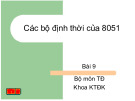

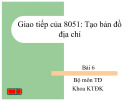
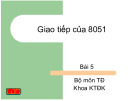
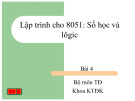
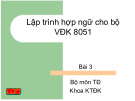
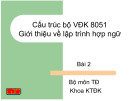
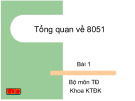
![Giáo trình Matlab trong điều khiển tự động: Phần 2 [Full/Chi Tiết]](https://cdn.tailieu.vn/images/document/thumbnail/2020/20200827/nguathienthan7/135x160/1612429000.jpg)
![Giáo trình Matlab trong điều khiển tự động: Phần 1 [Full]](https://cdn.tailieu.vn/images/document/thumbnail/2020/20200827/nguathienthan7/135x160/1596479025.jpg)














![Bài tập Lập trình C++: Tổng hợp [kinh nghiệm/mới nhất/chuẩn nhất]](https://cdn.tailieu.vn/images/document/thumbnail/2025/20250826/signuptrendienthoai@gmail.com/135x160/45781756259145.jpg)
